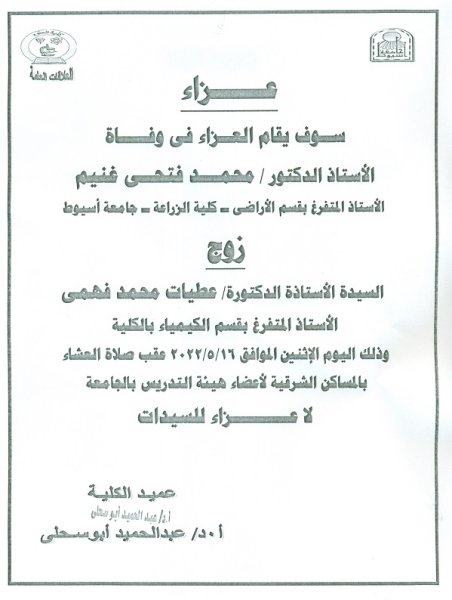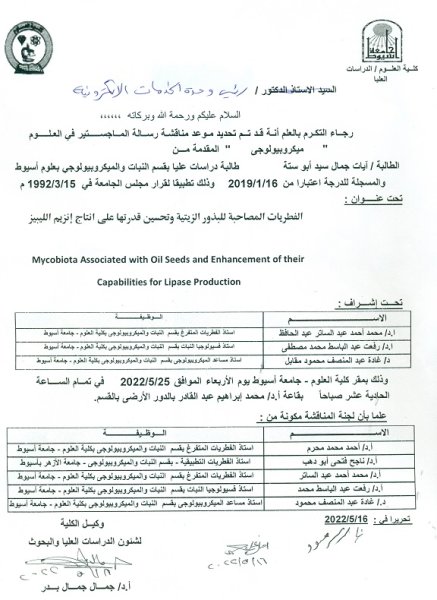
Do you have any questions? (088) 2345643 - 2412000 sci_dean@aun.edu.eg
Phyto-remedial of excessive copper and evaluation of its impact on the metabolic activity of Zea mays
Alleviating excess boron stress in tomato calli by applying benzoic acid to various biochemical strategies
Biosorption of ketoprofen and diclofenac by living cells of the green microalgae Chlorella sp.
There is a growing interest for the removal of different pharmaceuticals from water owing to their toxicity to various organisms. The present study investigated the use of living cells of the green alga Chlorella sp. in the short-term adsorption of ketoprofen (KET) and diclofenac (DIF) from aqueous solutions. The bioremoval efficiency of both KET and DIF was highly dependent on various parameters such as time, pH, algal dosage, and drug concentration. The adsorption efficiencies of both KET and DIC were maximized at pH 6. The biosorption of KET was better described by pseudo-first-order kinetics, while DIC obeyed the pseudo-second-order model. The maximum adsorption capacities of KET and DIF were attained as 0.328 and 0.429 mg g−1, respectively. The equilibrium data of the investigated drugs showed a better fit to the Freundlich model than the Langmuir model. The Elovich and Temkin models indicated that the algal surface was heterogeneous with different binding energies, while the intraparticle diffusion model assumed a boundary layer effect. Additionally, the Dubinin–Radushkevich isotherm indicated that the adsorption process was predominantly physisorption. FT-IR analysis revealed that H-bonding and n-π interactions were prominent in the biosorption process of the investigated pharmaceuticals on the surface of microalgae. The results of the present study showed that microalgae living cells could be applied as an eco-friendly and cost-effective biosorbent for the removal of KET and DIF at low concentrations.
Industrial optimization of alkaline and bleaching conditions for cellulose extraction from the marine seaweed Ulva lactuca
Marine macroalgae are abundant, sustainable, and low-cost resources for several biotechnological applications and are characterized by superior properties for the production of cellulose compared to lignocellulosic biomass. However, no attempts have been made in the optimization of cellulose extraction from marine macroalgae. The present study investigated the effects of different NaOH and NaClO2 treatments on cellulose yield and its physicochemical properties (molecular weight (MW) and crystallinity) from the green seaweed Ulva lactuca. In the first step, the Box-Behnken design (BBD) indicated that the optimum conditions for alkaline treatment were NaOH 5.0% (w/v), temperature 100 °C, and time 2.0 h. These conditions yielded 4.82% (w/w), with a MW of 2.91 KDa and crystallinity of 72.58%. Under these optimum conditions, a second BBD was developed to optimize bleaching conditions. The optimum bleaching treatment was NaClO2 concentration 2.50% (v/v), temperature 60 °C, and time 1 h, which extracted 5.50% (w/w) of cellulose, with a MW of 2.53 KDa and crystallinity of 93.47%. The results allowed the extraction of cellulose from marine algal biomass with sufficient yield and improved crystallinity for potential industrial applications.
Enhancement of microalgal biomass, lipid production and biodiesel characteristics by mixotrophic cultivation using enzymatically hydrolyzed chitin waste
There is a growing interest for the mixotrophic cultivation of microalgae using sustainable natural carbon sources. Chitin from shrimp waste was hydrolyzed using chitinase from Trichoderma asperellum and was exploited for the mixotrophic cultivation of microalgae. Chitin saccharification was optimized using Box-Behnken design to produce 50.41% (w/w) of reducing sugars using chitin, 0.83% (w/v), chitinase, 2.92 (v/v), temperature, 40 °C and time, 4.48 h. The biomass productivity of Tetradesmus obliquus and Aphanocapsa sp. was promoted to 39.1 and 40.57 mg L−1 day−1 in the presence of 0.5 g L−1 of N-acetylglucosamine oligomers (GlcNAc), which was estimated to be ∼1.9 and ∼2-folds higher than the autotrophic conditions, respectively. Modified Logistic kinetic model confirmed higher growth rates and shortened lag-time of the mixotrophic cultures. The lipid productivity of both microalgae species was >1.5-times higher than the autotrophic conditions. Nitrate removal from the culture medium was found to be an effective strategy to increase both lipid content and lipid productivity for T. obliquus, but this strategy was not effective for Aphanocapsa sp. Fatty acid analysis revealed an increase of saturated fatty acids under mixotrophic cultivation for both microalgae species. Additionally, several biodiesel evaluation parameters indicated superior characteristics for the mixotrophic culture compared to the autotrophic conditions. Accordingly, mixotrophic growth of microalgae using GlcNAc as a new, sustainable carbon and nitrogen source opens a new avenue for biofuel production with an effective waste conversion into valuable commodities.
Condolences
Bee gomogenat rescues lymphoid organs from degeneration by regulating the crosstalk between apoptosis and autophagy in streptozotocin-induced diabetic mice
Diabetes mellitus (DM) is a metabolic disorder that causes severe complications in several tissues due to redox imbalances, which in turn cause defective angiogenesis in response to ischemia and activate a number of proinflammatory pathways. Our study aimed to investigate the effect of bee gomogenat (BG) dietary supplementation on the architecture of immune organs in a streptozotocin (STZ)-induced type 1 diabetes (T1D) mouse model. Three animal groups were used: the control non-diabetic, diabetic, and BG-treated diabetic groups. STZ-induced diabetes was associated with increased levels of blood glucose, ROS, and IL-6 and decreased levels of IL-2, IL-7, IL-4, and GSH. Moreover, diabetic mice showed alterations in the expression of autophagy markers (LC3, Beclin-1, and P62) and apoptosis markers (Bcl-2 and Bax) in the thymus, spleen, and lymph nodes. Most importantly, the phosphorylation level of AKT (a promoter of cell survival) was significantly decreased, but the expression levels of MCP-1 and HSP-70 (markers of inflammation) were significantly increased in the spleen and lymph nodes in diabetic mice compared to control animals. Interestingly, oral supplementation with BG restored the levels of blood glucose, ROS, IL-6, IL-2, IL-4, IL-7, and GSH in diabetic mice. Treatment with BG significantly abrogated apoptosis and autophagy in lymphoid organs in diabetic mice by restoring the expression levels of LC3, Beclin-1, P62, Bcl-2, and Bax; decreasing inflammatory signals by downregulating the expression of MCP-1 and HSP-70; and promoting cell survival by enhancing the phosphorylation of AKT. Our data were the first to reveal the therapeutic potential of BG on the architecture of lymphoid organs and enhancing the immune system during T1D.
Isolation and identification of pathogenic biofilm-forming bacteria invading diabetic wounds
Diabetic foot ulcer (DFU) is the most serious diabetic complication. Gangrene is causing by the successive bacterial infection invading diabetic wounds and may lead to limb amputation for the diabetic patient. The bacteria inhabiting the wound exhibit the ability to forming biofilm, which is a protected mode of growth that allows cells to survive under harsh environments while also dispersing to colonize new niches. The main objective is to clarify the reasons of forming the bacterial biofilm, as well as, the multidrug resistant bacteria. The swab was used method for sample collection and bacterial isolation; different culture media as (BHI medium, MSA and TSA) were used for getting pure cultures from the pathogenic bacteria invading the diabetic wounds. Crystal violet was applied to detect the biofilm formed by these bacteria. Staphylococcus species are the most prominent bacteria invading the diabetic wounds forming a stable biofilm resistant to many antibiotics, one hundred bacterial isolated were recovered from diabetic foot ulcer belonging to five genus, namely, Staphylococcus sp., Klebsiella sp., E.coli, Pseudomonas sp., and Bacillus sp. using phenotypic analysis was confirmed by phylogenetic analysis.
Cellular targets and molecular activity mechanisms of bee venom in cancer: recent trends and developments
Bee venom therapy is known as a traditional approach to curing many medical conditions such as arthritis, pain and rheumatism. Bee venom also provides promising potential for treating many cancers such as breast, lung, ovary, stomach, kidney, prostate, cervical, colon and esophageal cancers, osteosarcoma, leukemia, melanoma and hepatocellular carcinoma. We therefore focused not only on the molecular activity mechanisms and cellular targets of bee venom and its components, but also on modern solutions as cutting-edge nanotechnological advances to overcome existing bottlenecks, and the latest advances in the anticancer application of bee venom in clinical settings.


